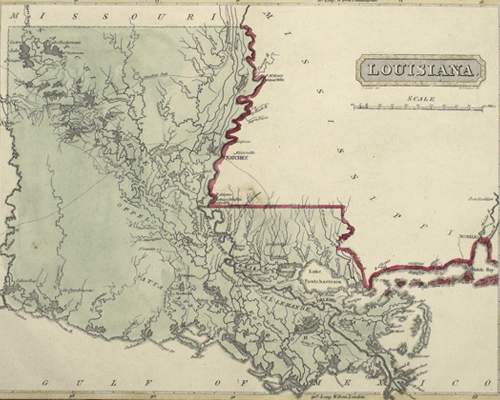2. Louisiana 1816 Electoral College
3. Louisiana 1816 Electoral College, Ballot 2
4. Louisiana 1816 Electoral College, Ballot 3
5. Louisiana 1816 Electoral College, Ballot 4
6. Louisiana 1820 Electoral College
7. Louisiana 1824 Electoral College
8. Louisiana 1824 Electoral College, Ballot 2
9. Louisiana 1824 Electoral College, Ballot 3
10. Louisiana 1824 Electoral College, Ballot 4
11. Louisiana 1824 Electoral College, Ballot 5

The State of Louisiana, lying at the mouth of the Mississippi, was so named in honour of Louis XIV in 1682. Louisiana of the seventeenth century extended from the Mississippi River to the Rocky Mountains, and from the Rio Grande and Gulf of Mexico to BritishAmerica. The cession of Louisiana by France to the United States took place on 20 December, 1803, and in 1804, Congress organized the territory of Orléans, which comprised a portion of the great district of Louisiana. In 1806 there were but 350 English-speaking white men in New Orleans. Between 1806 and 1809, 3100 Americans arrived. In 1809-10 came the immigration from the West Indies, due to the Santo Domingo and Haitian negro uprisings. In 1810 the Irish began to come, and they kept coming steadily for over forty years.
In 1811 Congress authorized the inhabitants of the territory to draw up a constitution, with a view to establish a state government. The constitution was adopted in 1812, and immediately thereafter, on 30 April 1812, Congress admitted Louisiana to the Union. Almost simultaneously with her admission, the war with England broke out, and on 8 January 1815, the famous battle of New Orleans, between 12,000 English soldiers under Pakenham and 5000 American recruits under Andrew Jackson, was fought within a few miles of the city of New Orleans, resulting in the overwhelming defeat of the British.
Bibliography
Electoral College
Elector: A member of the Electoral College chosen by the several States to elect the President and Vice-President.
Oxford English Dictionary
See President of the United States for the votes cast by the Electoral College for President.
Historical Note: These elections were vastly different from modern day Presidential elections. The actual Presidential candidates were rarely mentioned on tickets and voters were voting for particular electors who were pledged to a particular candidate. There was sometimes confusion as to who the particular elector was actually pledged to. Prior to the 12th Amendment, electors were pledged to two candidates as there was no distinction made in the Electoral College between President and Vice-President.
1789 - 1824: Alabama, Connecticut, Delaware, Georgia, Illinois, Indiana, Kentucky, Louisiana, Maine, Maryland, Massachusetts, Mississippi, Missouri, New Hampshire, New Jersey, New York, North Carolina, Ohio, Pennsylvania, Rhode Island, South Carolina, Tennessee, Vermont, Virginia
State Breakdown for Election of Members to the Electoral College:
Alabama: Legislature (1820), Popular Vote (1824)
Connecticut: Legislature (1789-1816), Popular Vote (1820, 1824)
Delaware: Popular Vote (1789), Legislature (1796-1824)
Georgia: Legislature (1789, 1792, 1800-1824), Popular Vote (1796)
Illinois: Popular Vote by District
Indiana: Legislature (1816, 1820), Popular Vote by District (1824)
Kentucky: Popular Vote by District
Louisiana: Legislature
Maine: Popular Vote by District
Maryland: Popular Vote (1789, 1792), Popular Vote by District (1796-1824)
Massachusetts: Popular Vote (1789-1796, 1804, 1824), Legislature (1800, 1808, 1816), Popular Vote by District (1812, 1820)
Mississippi: Popular Vote
Missouri: Legislature (1820), Popular Vote by District (1824)
New Hampshire: Popular Vote (1789-1796, 1804-1824), Legislature (1800)
New Jersey: Legislature (1789-1800, 1812), Popular Vote (1804, 1808, 1816-1824)
New York: Legislature
North Carolina: Legislature (1792, 1812), Popular Vote by District (1796-1808), Popular Vote (1816-1824)
Ohio: Popular Vote
Pennsylvania: Popular Vote (1789-1796, 1804-1824), Legislature (1800)
Rhode Island: Legislature (1792, 1796), Popular Vote (1800-1824)
South Carolina: Legislature
Tennessee: Popular Vote by District
Vermont: Legislature
Virginia: Popular Vote by District (1789-1796), Popular Vote (1800-1824)
Office Scope: Federal
Role Scope: State / District






